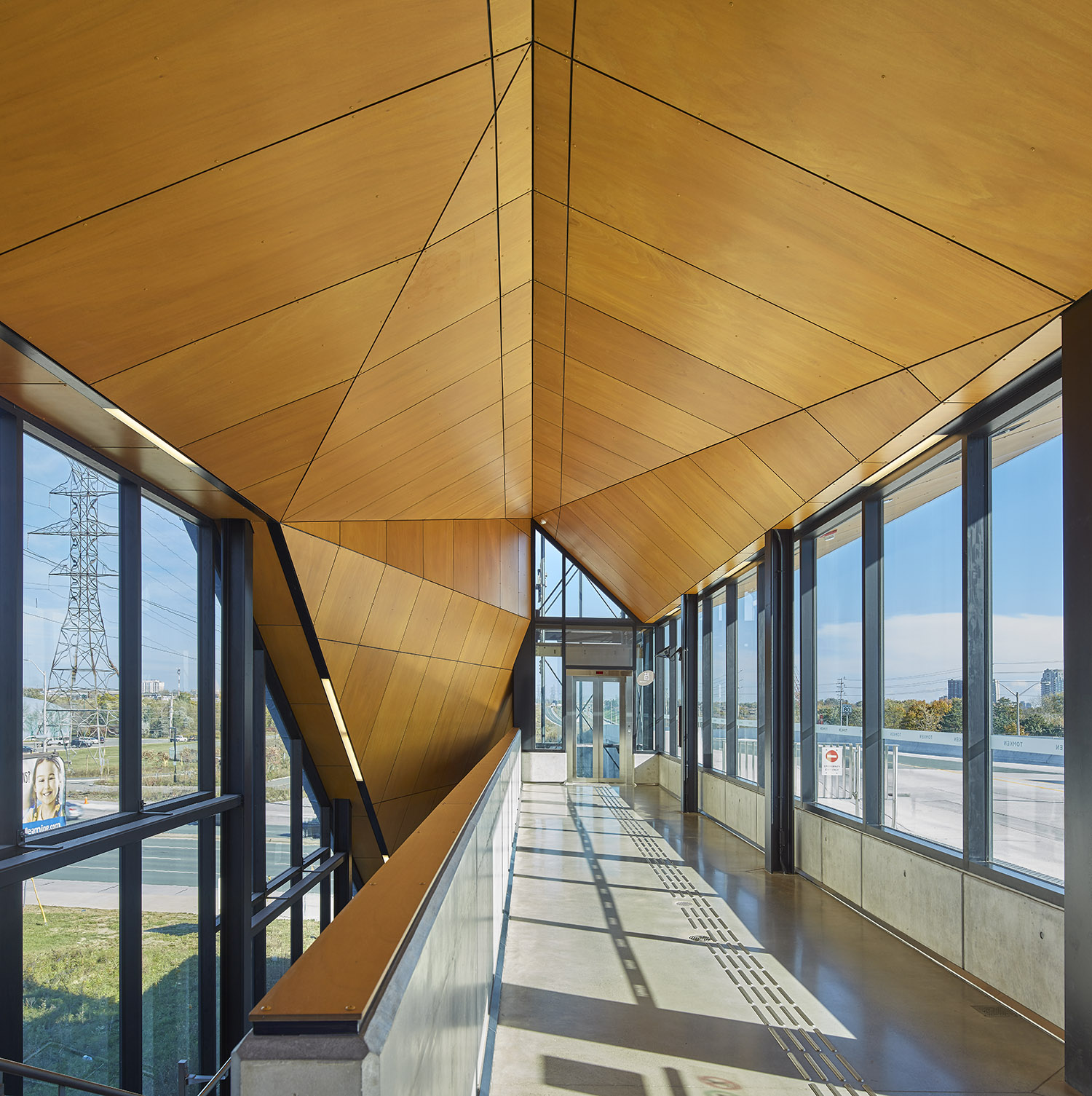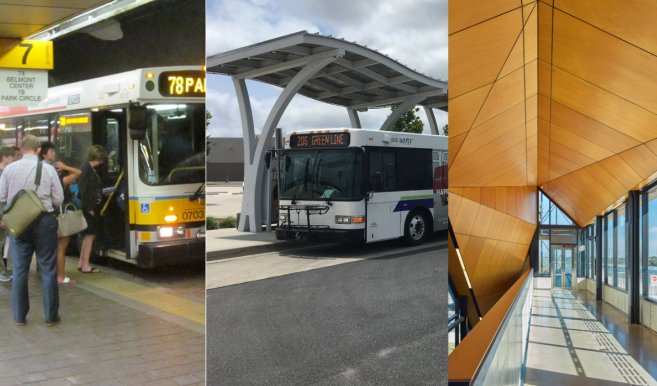Editor's note: this is the second first-round match-up in our America's Best Bus Stop Contest 2022. Don't forget to scroll to the bottom to vote, and click back to our first bout between Boston, Mass., Milwaukee, Wisc. and Albany, Calif. before those polls close at 11:59 pm on Sunday, March 20.
As we continue our quest to find America's best bus stop, we thought we'd bend the rules just a bit and take a look at bus stations — some of which serve a few other types of transit, too.
We know, we know: a full-on station is not the same as a standalone waiting area, and some of you might not think these behemoths belong in this contest at all. But as we combed through the submissions, we realized that a lot of these stops serve so many routes that they blur the line between "transit center" and the traditional "shelter-and-a-bench-next-to-a-sign" — and we thought there was a robust discussion to be had about everything a "bus stop" should be. (Don't worry, we'll get back to our usual bread-and-butter bus stops in the next bout.)
So let's dig deep, and take a look at three mega-stops that stunned us — and let's start underground.
Cambridge
If you look at this image and think "But Streetsblog, this is a subway stop!," well — you would be right. But if you zoom in, you'll see it that it serves trackless modes, too, — and nominator Ari Ofsevit says that, trains or no, it "may be the best bus station ever built."
Located underneath Harvard Square, the historic Harvard Station was originally built in 1912 for streetcars, though the land where today's station stands served as a pick-up for horse-drawn omnibuses as far back as 1826. (Fun/depressing fact: the horse-buses ran on ten minute headways, a frequency which puts a lot of today's routes to shame.)
Today, it's a robust multimodal center that serves a subway and a whopping 13 different bus lines on any given day, making it the third-busiest station in the entire Massachusetts Bay Transportation Authority's sprawling network.
What Ofsevit might like most about Harvard Station, though, is its accessibility, which is unique for a super-old stop in a legacy system (though, hopefully, that will change with the passage of the Bipartisan Infrastructure Law, which contains some great provisions for retrofitting inaccessible stops.)
"Getting off the train, passengers travel up or down a ramp to an atrium rebuilt in the '80s which may be the best modern architecture in the system (almost at [Washington Metropolitan Area Transit Authority] levels), and then two sets of ramps lead to two bus levels," Ofsevit wrote. "This way, no passenger has to climb stairs or change multiple levels. Once in the busway, they wait for the bus in a fully-enclosed dry space, then step onto the bus for the rest of the trip."

Of course, most cities today probably couldn't build a Harvard Station of their own, at least without some serious changes to policy, funding, and community priorities — and if you prefer a 21st century bus facility to an older station that got a leg up simply by being built before the mass proliferation of the automobile, this might not be your pick.
Still, there's no denying that a bus stop with this much history and style deserves a spot in this contest.
Lewes, Del.
There's no doubt that this mega bus stop is a model many modern cities could follow, considering that it opened just three years ago. Unlike Harvard, though, the Lewes Transit Center focuses exclusively on buses — with a heavy dose of regional bus service that get people to the nearby beach towns without ever getting in the car.
Yep: if President Biden ever wanted to skip the motorcade on his way to his gazillion-dollar summer house on Rehoboth Beach, he'd probably need to pass through Lewes on the way. Yes, interstate and paratransit routes stop there too, and all passengers are met with their choice of a comfortable outdoor bus shelter or a cush indoor waiting facility, which we couldn't fit in the screenshot.
"This is a fantastic regional bus center that offers comfortable, context-sensitive solutions for multi-modal transportation," said nominator Savannah.

Of course, in transit-poor Lewes, that "context" is pretty damn car dependent. The transit center features a free, 246-space "Park-and-Ride" lot, and it sits alongside a seven-lane highway with no crosswalk directly to the station, and no bike lanes to speak of, either, despite some nominal bike racks. Streetsblog has written a whole lot over the years about the problems with Park-and-Ride at transit, so please: don't @ us.
It should be noted, though, that Lewes is a town of just 3,200 people at the very, very beginning of its public transit journey — the local council just started tossing around the idea of its first-ever downtown jitney a few weeks ago — which is exactly the kind of situation that transit experts like Jarrett Walker say might merit a Park-and-Ride approach, at least until the city intensifies around its new transit amenity.
"The claim that Park-and-Ride is needed to attract riders is true only in the earliest phases of development, or on transit services with limited utility like peak-only express service," wrote Walker in one of his classic Human Transit blog posts. "This is why Park-and-Ride is often a logical interim use of land, but not one that you should plan on having forever."
The Lewes transit center, which does, indeed, run peak service during the summer months to get families to the seaside without clogging up area roads, pretty much fits that description — and if your idea of a great bus stop is one that expands shared transportation to more people without skimping on the amenities, this might be your pick.
Mississauga, Ont.
We were very reluctant to give a Canadian spot in this year's contest, considering how much the Great White North has absolutely dominated the last few Sorriest Bus Stop Contests. (We love you, Canucks, but man...give the Yanks a chance.) But we couldn't resist including this suburban Ontario stop, which makes a lot of America's sad suburban commuter stations look downright shabby.
Since it first opened in 2014, this Toronto-area stop known as the Tomken Station has had the unique distinction of serving the dedicated bus-only Mississauga Transitway, which is fully separated from car traffic — and at this particular station, actually elevated above the road — for its entire 18 km (11 mile) length. The station itself also sends a clear signal that bus passengers are literally the city's highest priority, with an enclosed, ADA-accessible, elevated station that feels like it was ripped right out of Architectural Digest.
And before you ask: there's not a lick of parking.
"The Tomken Station is a bus station on steroids," wrote our anonymous submitter. "Modern and elevated in the sky, it outclasses many rail stations. This is what you do if you need to get commuters into buses."
Seriously, check out this architect's glamor shot of the interior:

Purpose-built bus only roadways are definitely a luxury not every region can afford, and if you'd like to keep the focus on United States bus stops this year, this might not be your pick. We also didn't spot a whole lot of seating at Tomken based on the photos we could find, but maybe they're hiding away somewhere.
Still, it's a beauty, and strong proof that suburban waiting areas can be every bit as wonderful as urban stops that serve a dense population.
It's time to vote. Which bus stop behemoth deserves a spot in the next round? Cast your vote by 11:59 pm on Tuesday, March 22.
Here's the full bracket if you're following along at home.






